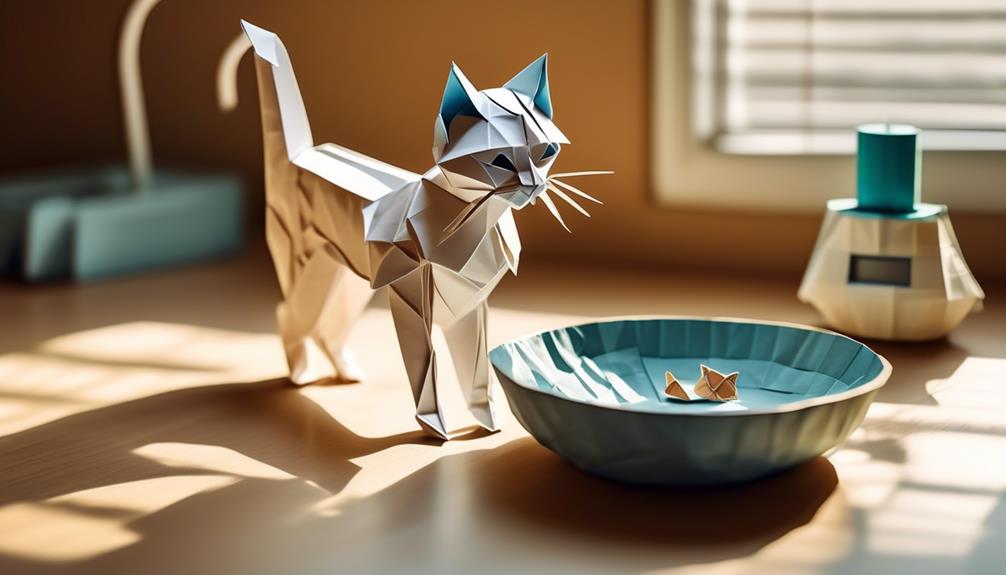When your cat enters their golden years, managing their ‘sugar quirks’ becomes an essential part of their daily care. You’re not alone in this journey, and with the right approach, you can help your cat maintain a comfortable quality of life.
It’s about knowing the balance—ensuring they’re getting the nutrition they need without tipping the scales. You’ll want to stay vigilant with their blood sugar levels, recognizing that consistent monitoring can be a lifeline.
Let’s not forget the importance of a tailored insulin regime; it’s not a one-size-fits-all situation, and close collaboration with your vet can make all the difference.
And while these steps are critical, there’s more to uncover about the nuances that can help your senior cat thrive despite their condition. Stay with us as we explore these strategies further, and discover how small changes can have a big impact on your cat’s well-being.
Key Takeaways
- Tailor the diet to combat diabetes by focusing on low-carbohydrate, high-protein foods and considering special diabetic cat foods or an all-canned food regimen.
- Monitor blood glucose levels regularly through blood glucose curves and utilize continuous blood glucose monitoring systems.
- Adjust insulin doses appropriately based on glucose levels and regularly monitor your cat’s health, reporting any variations to the vet.
- Maintain routine blood glucose checks, monitor for signs of diabetic ketoacidosis, and create a calm and stress-free environment for your cat’s well-being.
Optimize Dietary Management
To best support your aging cat’s health, it’s essential to frequently assess and tailor their diet to combat diabetes with a focus on low-carbohydrate, high-protein foods. Diabetic cats particularly benefit from a diet that stabilizes their blood glucose levels. A carefully planned low-carbohydrate diet can significantly contribute to their well-being and may even lead to remission of feline diabetes in some cases.
You’ll want to consider special diabetic cat foods or an all-canned food regimen that aligns with your cat’s health requirements, weight goals, and personal preferences. It’s crucial to manage their diet alongside insulin therapy. Coordinating feeding times with insulin injections, generally twice daily, ensures that your cat’s blood sugar levels remain stable and reduces the risk of hypoglycemia. Always ensure they eat before administering insulin.
It’s a commitment, but by consistently monitoring your cat’s health—keeping an eye on changes in appetite, weight loss, and water intake—you’ll be able to report any significant variations to your vet promptly. This attentive oversight is key to effective dietary management.
Regular Blood Glucose Monitoring
While managing your cat’s diet is a cornerstone of diabetes care, equally vital is the practice of regular blood glucose monitoring to keep their levels in check. You’ll find that being attentive to your cat’s health not only helps manage their condition but also strengthens the bond you share.
Here are three key steps to effective monitoring:
- Learn to Perform Blood Glucose Curves: You can perform blood glucose curves at home to assess your cat’s glucose concentrations before and after insulin injections. This involves using a glucose meter calibrated specifically for cats to measure blood glucose levels at different times.
- Utilize Continuous Blood Glucose Monitoring: These systems provide frequent readings and can reduce the stress on both you and your cat, as they minimize the need for repeated needle pricks.
- Adjust Insulin Doses Appropriately: When glucose levels are high, it may indicate a need to adjust your cat’s insulin dosage. Regular blood glucose monitoring ensures that you’re providing the correct amount of insulin.
Tailored Insulin Therapy
Understanding your aging cat’s unique needs is the key to crafting an effective Tailored Insulin Therapy plan, ensuring their diabetes is managed with the utmost care. As you work closely with your veterinarian, you’ll find that the right dose of insulin is pivotal for your cat’s health. This dose is calculated based on their weight, blood glucose concentration, and how they’ve responded to previous insulin therapy.
It’s essential to maintain a near-normal blood glucose level to reduce the risk of complications and increase the chances of diabetic remission within your cat’s lifetime. Regular adjustments to the insulin dose are necessary and should be based on thorough glucose curves and, if possible, continuous glucose monitoring. Administering insulin twice daily is often recommended to stabilize blood glucose levels.
Remember, too high a dose can lead to low blood sugar, which is dangerous. Here’s a snapshot of what Tailored Insulin Therapy might look like:
| Factor | Consideration |
|---|---|
| Cat’s Weight | Basis for initial insulin dose calculation |
| Blood Glucose Monitoring | Adjusts insulin dose for optimal control |
| Type of Insulin | Selected for best glycemic control |
| Frequency of Administration | Twice daily to maintain blood glucose levels |
With a gentle hand and a watchful eye, you’re providing your cat with the best care possible.
Monitor for Complications
Keeping a vigilant eye on your beloved cat’s health will help you catch any signs of complications early, ensuring that their diabetes management remains on track. Diabetes in cats requires close monitoring, not only of their blood glucose levels but also of their overall well-being.
Here are a few strategies to help you monitor for complications:
- Regular Blood Glucose Checks: Maintain a routine of checking your cat’s blood glucose reading. This can be done through traditional methods or with the help of a continuous glucose monitoring system, which minimizes stress for both you and your pet.
- Watch for Signs of Diabetic Ketoacidosis: Diabetic ketoacidosis is a severe condition that can occur in diabetic cats. Be alert for symptoms such as vomiting, lethargy, or an abnormal breath odor, and seek veterinary care immediately if these arise.
- Monitor Overall Health: Observe any changes in your cat’s weight, appetite, and their urination habits. Frequent urination might signal a urinary tract issue or chronic kidney disease, which can be a complication of diabetes.
Adjust Lifestyle Factors
To effectively manage your aging cat’s diabetes, consider adjusting their lifestyle to include a specialized diet and regular exercise tailored to their needs. A diet for a diabetic cat should be low-carbohydrate and high-protein. This helps in regulating blood glucose levels, which is pivotal in the treatment of diabetes. By focusing on the right food, you’re supporting your cat’s body in maintaining a healthy weight, crucial for managing this condition.
Exercise is another cornerstone of diabetes management. Encouraging your cat to engage in physical activity not only assists with weight control but also improves their body’s sensitivity to insulin, promoting better glucose regulation. This could be as simple as interactive play sessions that entice them to move more.
Ensure your cat’s clinical care is consistent by administering prescribed insulin doses at the same daily times to stabilize glucose levels. Monitor your cat’s reaction to lifestyle changes and keep in close contact with your vet for any necessary treatment adjustments.
Creating a calm environment can significantly impact your cat’s well-being and aid in managing their diabetes. A stress-free home is a key ingredient in a holistic approach to your cherished cat’s health.
Frequently Asked Questions
How Do You Take Care of a Senior Cat With Diabetes?
You’re facing a challenge, but caring for your senior diabetic cat means ensuring they eat low-carb meals, monitoring their blood sugar, giving insulin shots, and visiting the vet regularly. You’ve got this.
How Do You Treat Old Cats With Diabetes?
You’ll treat your old cat’s diabetes with consistent insulin shots, a specialized diet, and regular glucose monitoring. It’s essential to manage with care, aiming for their comfort and well-being.
How Long Can a Senior Cat Live With Diabetes?
You’re wondering about your senior cat’s lifespan with diabetes. With proper care, they can live into their late teens, enjoying quality life alongside you. It’s about managing well and giving consistent love and support.
How Can I Control My Cats Diabetes Naturally?
You might worry natural methods won’t suffice, but starting with a low-carb diet and consistent blood glucose monitoring can effectively manage your cat’s diabetes, ensuring they’re as healthy and comfortable as possible.




